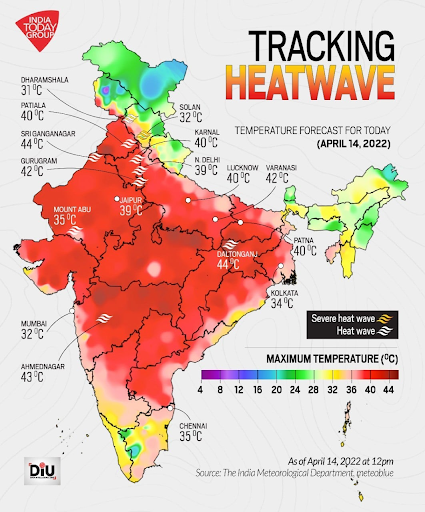Heatwaves
What is it?
- A heatwave is a period of unusually hot weather with above normal temperatures that typically last three or more days. In India, heatwaves are generally experienced during March-June.
- The extreme temperatures and resultant atmospheric conditions adversely affect people living in these regions as they cause physiological stress, sometimes resulting in death.
- A heatwave occurs when a system of high atmospheric pressure moves into an area and lasts two or more days. In such a high-pressure system, air from upper levels of our atmosphere is pulled toward the ground, where it becomes compressed and increases in temperature.
How are heatwaves defined?
- A heatwave is declared when the maximum temperature is over 40 degree Celsius and at least 4.5 notches above normal.
- A severe heatwave is declared if the departure from normal temperature is more than 6.4 degrees, according to the IMD. Based on absolute recorded temperatures, a heatwave is declared when an area logs a maximum temperature of 45 degree Celsius. A severe heatwave is declared if the maximum temperature crosses 47 degrees.
Heatwaves in India
- On an average, two-three heatwave events are expected every season. Heatwaves are predominantly observed over two areas, central and northwest India and another over coastal Andhra Pradesh and Odisha, supported by favourable atmospheric conditions.
- Total duration of heatwaves has increased by about three days during the last 30 years and a further increase of 12-18 days is expected by 2060.

Impact in India
- Heatwaves have multiple and cascading impact on human health, ecosystems, agriculture, energy, water and economy.
- The recent 2022 heatwave in India and Pakistan in March-April has led to at least 90 deaths across India and Pakistan.
- It also triggered an extreme Glacial Lake Outburst Flood(GLOF) in northern Pakistan.
- Read about GLOF at https://officerspulse.com/flash-flood-2/
- The extreme heat reduced India’s wheat crop yields from Punjab and Uttar Pradesh. There have been power outages due to shortage of coal.
Causes
- Heatwaves are caused by large-scale atmospheric circulation anomalies like high pressure areas, upper-tropospheric, jet streams, etc.
- Global forcing like the El Nino/Southern Oscillation (ENSO) and the Indian Ocean modulate the frequency and duration of Indian heatwaves.
- Heatwave can be further accentuated by local effects like depleted soil moisture and enhanced sensible heat flux.
How good is our early warning system for heatwaves?
- Under the National Monsoon Mission, the Ministry of Earth Sciences (MoES) had established an advanced prediction system for early warnings of heatwaves.
- IMD has the capability to predict the genesis, duration and intensity of heatwave events with reasonable accuracy up to four-five days in advance.
- Hindcasts from the MoES Extended Range Prediction System (ERPS) uses ensemble method combining four atmospheric general circulation models that can predict heatwaves two weeks in advance
- Indian heatwaves can be predicted even one season in advance using 37 years (1981-2017) of hindcasts from the Monsoon Mission Coupled Climate Forecast Model (MMCFS) that document seasonal predictions of frequency and duration of Indian heatwaves during April-June.
Measures needed
- Developing a comprehensive heat response plan that includes early warnings, awareness rising and technology intervention. Early warning systems are an integral part of this heat action plan.
Mains Question: What are Heat waves? Discuss the reasons for increasing incidents of heat waves, and its impacts
Reference:
Subscribe
Login
0 Comments
